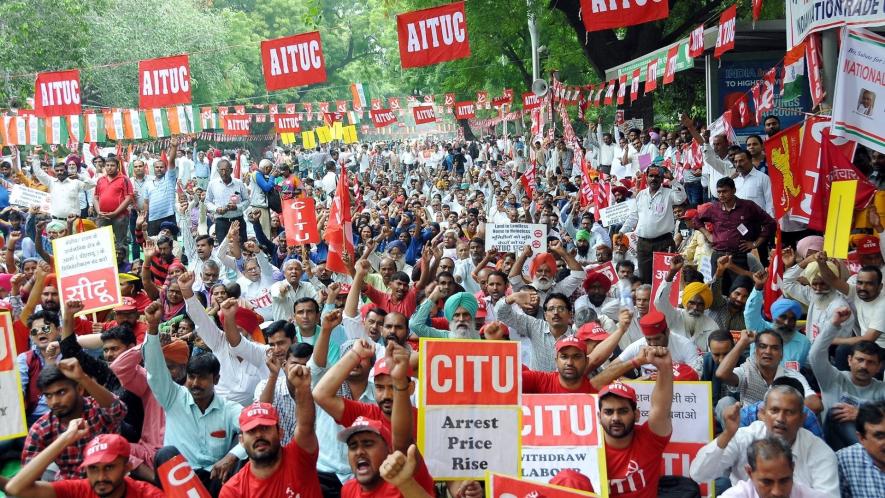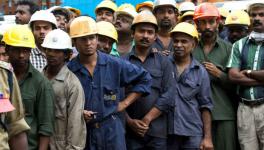Why Are Millions of Indian Workers Preparing for a National Strike on January 8?

housands of workers from across India took part in a national convention on labor rights in New Delhi on September 30
Ever since the far-right government of Narendra Modi returned to power in May 2019, it has accelerated the implementation of both its Hindu fundamentalist agenda, as well as pro-corporate neoliberal policies. A cornerstone of the latter has been the systematic attack on workers’ rights that were gained through decades of struggle. Through a combination of privatization, under-funding of the public sector and dilution of labor laws, the Modi government is going all out to target the organized working class, which remains a major barrier to the supremacy of the right wing in India.
However, the workers of India have refused to accept these laws and are preparing to resist. 10 national trade unions and a number of other independent workers’ associations have jointly given a call for a country-wide strike action on January 8, 2020. This call was given at a national mass convention of workers held on Parliament Street in New Delhi on September 30. Thousands of workers across sectors from different States attended this convention.
The pace of privatization of strategic sectors has accelerated under the Modi-led Bharatiya Janata Party (BJP) government. 100% Foreign Direct Investment (FDI) has been allowed in almost all sectors, including the defense industries. The government has also been increasing concessions to corporations even as it reduces the workers’ already meager minimum wage and dismantles the social security structure. Labor protection laws are being scrapped and the inspection mechanisms to verify compliance with them are slowly getting weaker.
According to data from the Centre for Monitoring Indian Economy, the unemployment rate of the Indian economy was almost 10% at the end of September, a record 45-year high. Unemployment among youth between the ages of 20 and 29 has increased by 73% over the last two years, reaching 28%. As many as 30-35% of those who do have jobs are categorized as underemployed, which means their work does not match their qualifications.
An economy in severe crises
Unemployment has increased in absolute terms over the past two years. Therefore, not only has there been no net job creation to accommodate the approximately 4.75 million new workers that enter the Indian labor market each year, but as many as 4.7 million existing jobs have been lost.
Households have been forced to use up their savings, held in the form of bank deposits, property or gold and silver ornaments, to survive the soaring rise in prices. This is evident from the fact that the percentage of GDP made up of household savings declined from 19.6% in 2014-15, when the BJP came to power, to 17.2% in 2017-18, according to the latest available data of the Reserve Bank of India.
Meanwhile, household liabilities have increased in the same period from 3% of the GDP to 4.3%. Outstanding personal loans, which remained at a steady 9% from 2012 until the BJP came to power, have since then shot up to 11.7%, as of March.
The agrarian distress, which has already pushed thousands of farmers to commit suicide, has also become more severe under the present regime.
The government has been assuming that its neoliberal policies will automatically ratchet up the growth rate. However, the opposite has happened, with the GDP hitting a six-year low of 5% in the April-June quarter of the current fiscal year.
There has been a sharp decline in the purchasing power of the common person because of rising unemployment, stagnant wages and the increasing costs of necessities, including electricity, public transport and medicines. Due to this, the demand for basic commodities has sunk in the domestic market, leaving 25% of the productive capacity of the industrial sector unutilized.
Amid all this, corporate net profits grew by 22.3% during 2018-19. Social inequality has been aggravated to such an extent that the richest 1% cornered 73% of the total wealth produced in the Indian economy last year, leaving a mere 2% to be shared among the poorest half of the country’s population – about 670 million people.
To bolster corporate profits further, the finance minister reduced the corporate tax from an average of 30% to 25.17%, effectively bringing down the corporate tax-rate to 22%. This, combined with other concessions made to corporations, amounts to Rs 1.45 trillion (over USD 20 billion) in income losses for the government. This is even as in the name of maintaining fiscal discipline, there has been a sharp reduction in expenditure on social welfare and public investment across sectors, as announced in the recent budget in July.
The toiling masses of India are deeply resentful of the government for its policies and there have been numerous country-wide strikes and demonstrations over the past three years. The participation in these protests has been massive, drawing hundreds of thousands of workers and peasants from across the country.
The right wing’s only response has been to launch a massive and virulent propaganda campaign. Anyone who speaks out against the government is immediately branded a traitor. This has been accompanied by carefully cultivated religious polarization, especially targeted against Muslims, along with a hyped-up jingoism directed against Pakistan. The focus of all these efforts has been to instill among sections of the Hindu majority a feeling that all is well with the country as a pro-Hindu government is in power.
Intensified assault on labor rights
Meanwhile, the assault against labor continues. The main aspect of this attack is the replacement of 44 central labor laws with four labor ‘codes.’ The first of these, the Code on Wages, has already been enacted and replaces the Payment of Wages Act, 1936, the Minimum Wages Act, 1948, the Payment of Bonus Act, 1965, and the Equal Remuneration Act, 1976.
Through this code, the government has effectively reduced the national minimum wage. The labor minister announced Rs.178 ($2.5) per day as the new national minimum wage, in contradiction to the recommendation of the expert committee he himself had appointed in his previous term, which prescribed Rs. 375-447 ($5.2-6.29) per day.
This prescribed amount is in itself below the wage required to afford 2700Kcal per day, which was accepted in the Labor Conference of 2016 as the standard to which the national minimum wage has to be pegged.
A minimum wage pegged to this standard would be Rs. 692 ($9.74) per day or Rs.18,000 ($253) per month. The current amount is a quarter of what is required to afford this nutritional minimum of calorific intake prescribed by the Indian Council of Medical Research.
Also, Rs. 178 per day is only two rupees ($0.028) more than the minimum wage declared in 2017. Factoring in the inflation rate since then, the mere two rupees hike amounts to an actual reduction of minimum wage in real terms. Further, even this ‘starvation wage’ is not guaranteed to at least 85% of the workforce, because this code is not applicable to enterprises employing less than 10 workers or the informal sector.
The section of the code which lays down rules of employment and fines for absence from duty states that “any employee who is under the age of fifteen years” shall not be fined. What has shocked many observers is the fact that a child has been referred to as an “employee”, which is a legitimization of child labor.
At the same time, penalties for non-compliance have been diluted and enforcement mechanisms have been relaxed. The code replaces labor inspectors with “inspectors-cum-regulators” who “shall, before the initiation of prosecution for the offenses” give “an opportunity to the employer to comply with the provisions of this code by way of a written direction, which shall lay down a time period for such compliance.”
While the time period for this compliance has not been specified, it has been mandated that if the employer complies “within such period, the Inspector-cum-Facilitator shall not initiate such prosecution.” Moreover, prosecution may be initiated against an employer only “if the violation of the same nature of the provisions under this Code is repeated within a period of five years from the date on which such first violation was committed.”
Also lined up for parliament’s approval is the Occupational Health, Safety and Working Conditions Code 2019, which replaces 13 labor laws including the Factories Act, the Contract Labour Act and other laws regulating the employment of migrant workers and those working in specific areas such as docks and plantations.
Both these codes place the final responsibility of compliance on the labor contractor, rather than the primary employer who outsources to the contractors as a cost cutting exercise. This has been termed as a conscious policy to encourage further contractualization, which is among the primary complaints being raised by the working class in the country.
The Code on Social Security, whose draft has also been prepared, replaces eight laws including the Maternity Benefit Act, 1961, the Payment of Gratuity Act, 1972, and the Unorganized Workers’ Social Security Act, 2008.
As if in anticipation of the labor unrest, the code on industrial relations seeks to restrict the registration of trade unions, and imposes a number of pre-conditions that have to be met before undertaking a strike action. These pre-conditions, critics have argued, amounts to an attempt to effectively ban strikes.
Speaking at the national convention, Tapan Sen, general secretary of the Centre of Indian Trade Unions (CITU) and Politburo member of the Communist Party of India (Marxist), said that it was up to the working classes to save the country from such policies, as well as the loot of national assets through privatization. He reiterated that it is the working class struggles that have prevented the government from pushing through all these measures for the past five years.
“Our demand behind the January 8 strike action will not be ‘Don’t bring FDI’,” he said. “Instead, we should proclaim firmly to the government, ‘Try and do it, and we will show you that it cannot be done in the face of our resistance’.”
Get the latest reports & analysis with people's perspective on Protests, movements & deep analytical videos, discussions of the current affairs in your Telegram app. Subscribe to NewsClick's Telegram channel & get Real-Time updates on stories, as they get published on our website.






















